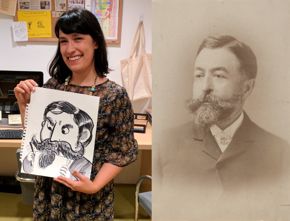Caricaturing a Caricaturist: Thomas Nast Today August 15, 2017

Left to right: Illustrator Maria Heg shows off her drawing of Thomas Nast. Bust-length Portrait of Thomas Nast, c. 1888, photograph, The Metropolitan Museum of Art, gift of Thomas Nast, Jr., Mabel Nast Crawford and Cyril Nast, 1933. Courtesy of The Metropolitan Museum of Art
Thomas Nast, The Cat’s Paw – Anything to Get Chestnuts, from Harper’s Weekly, 1872, wood engraving on newsprint, the Museum of Fine Arts, Houston, the Mavis P. and Mary Wilson Kelsey Collection.
Perhaps the quintessential American caricaturist, Thomas Nast (1840–1902) provided an almost encyclopedic overview of the political landscape of 19th-century America through his satirical prints. The Museum’s Mavis P. and Mary Wilson Kelsey Collection includes more than 1,000 impressions of Nast’s prints, published over 30 years in periodicals such as Harper’s Weekly.
A new online exhibition highlighting the history of caricature, Funny Faces: Satirical Prints and Drawings at the Museum of Fine Arts, Houston, includes samples of Nast’s prints along with works on paper by Honoré Daumier, Francisco de Goya, Jusepe de Ribera, and other masters. Funny Faces also features a video of Houston-based illustrator and cartoonist Maria Heg demonstrating the formal process of artful exaggeration with her own caricature of Nast. I sat down with Maria to discuss what she sees in Nast and his work today.
When you were caricaturing a photo of Thomas Nast for the Funny Faces online exhibition, was one visual element more difficult to exaggerate than another?
The shape of his face was somewhat difficult to capture, since it’s round though he wasn’t a heavyset man. But to be honest, I think his features are more difficult to exaggerate than his highly distinctive facial hair!
It can be hard to relate to the humor of satirical prints that are more than a century old! Are there aspects of Nast’s work that you still find funny and relevant?
I do appreciate his extensive takedown of Boss Tweed, and the way many of the depictions of the corrupt politician were prototypes for trust-busting cartoons of the later Gilded Age—in particular, the figure of the corpulent industrialist with a bag of money for a head. Nast’s Tweed comics still resonate today.
Nast published his satirical work as wood engravings in print periodicals. How has dissemination evolved since then?
With fewer than 40 staff cartoonists working for newspapers in the United States today, one might argue that print is dead, or that one cannot make a living with it anymore. However, periodicals such as the New Yorker still actively publish cartoons, and the Nib and other digital outlets are publishing some of the most incisive and contemporary topical cartooning around. Additionally, digital dissemination has really transformed the medium: Now individual creators can distribute their own work in their own way. There are options, but that said, there are certainly fewer traditional outlets than Nast had.
See more caricatures in Funny Faces: Satirical Prints and Drawings at the Museum of Fine Arts, Houston, via Google Arts and Culture!





